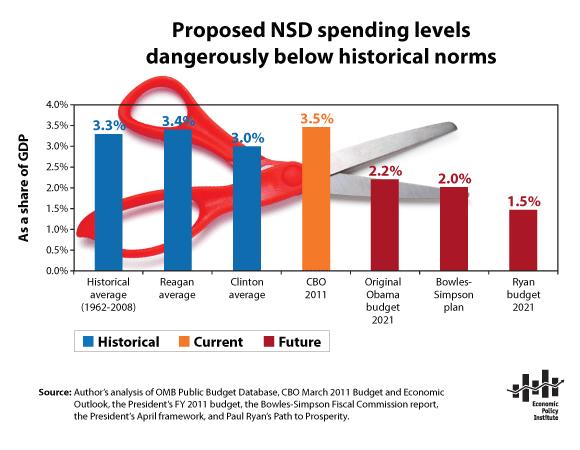Major budget proposals slash public investments
Although the outcome is still in question, the recent debate over raising the debt ceiling has been dominated by discussions of cuts to non-security discretionary (NSD) spending. The majority of the proposed budget plans discussed so far focus disproportionately on the NSD budget, which funds investments in education, transportation infrastructure, housing, and health care, all of which are critically important to our nation’s well-being and growth. In the report Major Budget Proposals Pit Public Investment Against Vital Services, EPI policy analyst Ethan Pollack examines the current competing plans—President Obama’s 2012 budget proposal, the Bowles-Simpson debt commission’s plan, and House Budget Committee Chairman Paul Ryan’s budget resolution—and finds that each would make severe cuts to the NSD budget, diminishing it by 2021 to levels not seen since before 1962.
If implemented, these cuts could add up to “crumbling roads and bridges, a second-class education system, a dirty and hazardous environment, lax consumer protections, and a government that can’t function,” Pollack states.
This week’s Economic Snapshot, Proposed NSD spending levels dangerously below historical norms, puts these proposed cuts into context.
“The proposals by Obama, the Bowles-Simpson commission, and Wisconsin Rep. Paul Ryan will all cut the NSD budget to unprecedented low levels that would likely result in severe cuts to public investments—thus jeopardizing the president’s goal to “win the future”—or a near elimination of every other part of the NSD budget, including, ironically, Congress itself,” the Snapshot explains.
J visa program fails to protect workers and operates with little oversight
Today, new State Department regulations for the Summer Work Travel (SWT) program will go into effect. The narrow scope of these new regulations, however, will likely do little to address the program’s failings. In the new study Guestworker Diplomacy, EPI policy analyst Daniel Costa scrutinizes the SWT program as well as the problematic J visa program of which it is a part. In the paper, Costa details the history of the J visa program (now the largest U.S. guestworker program in terms of annual admissions), examines its problems, and prescribes steps the State Department must take to begin to correct them.
One of the most troubling aspects of the J visa Exchange Visitor Program is that it gives U.S. employers significant financial incentives to hire foreign workers instead of U.S. workers, yet offers no genuine labor protections for these foreign guests. Although the State Department officially oversees the J visa program, it defers most of its oversight responsibilities to the actual employers and organizations sponsoring J visas. With virtually no government oversight, these employers have little to no reason to regulate themselves against exploitative practices. For instance, unlike other guestworker programs (H-1B, H-2A and H-2B), the J visa has no prevailing wage requirement, which enables employers to pay J visa holders wages that are lower than those earned by U.S. workers in the same region and occupation.
“The State Department’s J visa Exchange Visitor Program has ballooned into a massive guestworker program and is desperately in need of reform,” said Costa. “Congress must investigate the rampant abuse of the program and the negative impacts it is having on the U.S. labor market and unemployed U.S. workers, and terminate or suspend the Exchange Visitor Program until these problems can be adequately addressed.
Job seekers ratio continues 29-month rut
On Tuesday, the Bureau of Labor Statistics released its monthly Job Openings and Labor Turnover Survey (JOLTS) report, providing more evidence of the nation’s ongoing jobs crisis. The number of job openings increased by a mere 21,000 in May for a total of 3.0 million job openings. The total number of unemployed workers was 13.9 million, which equates to 4.7 unemployed works for every job opening.
In his analysis of the report, EPI president Larry Mishel notes how sobering these numbers are: for almost two-and-a-half years there has been no available job for at least three out of four unemployed workers.
“The key difference between this and other recoveries has been that there have been far fewer job openings in this recovery, reflecting the aftermath of a financial crisis and a shortfall in demand. In the first 23 months of recovery after the 2001 recession, there were a cumulative total of 82.5 million job openings. In the first 23 months following the 2007 recession, however, there were only 64.4 million, 22% less.”
EPI in the News
In the past week EPI’s experts have been cited over 300 times in television, radio, and print media. Some of the highlights include:
In the article Marathon Economic Talk America Needs, The National Journal cited EPI economist Rob Scott’s work on the importance of revaluing China’s currency.
The New York Times cited EPI’s research on the discrepancy between executive pay and wage growth for typical college graduates. The New York Times also cited EPI’s tracking of the jobs crisis in the article, Unemployment? Who cares? Guest columnist Nancy Folbre wrote: “Progressive think tanks like the Economic Policy Institute carefully monitor employment trends.”
In the article, How different are taxes and spending?, The Washington Post’s Ezra Klein quoted EPI president Larry Mishel:””The Republicans argue that increasing taxes by a dollar hurts the economy while cutting spending by a dollar helps the recovery…That means they believe that taking a dollar out of a rich person’s pocket through taxes hurts demand while taking it out of a poor person’s pocket by cutting unemployment insurance doesn’t,’ said Mishel.”
